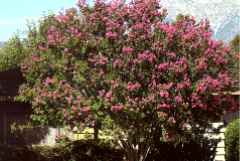Vol.
2 #119
May 11, 2001
|
CRAPE MYRTLE...Singing
In The Sunshine
|
 The
Fredericksburg area usually thinks of dogwoods (Cornus florida)
and red buds (Cercis canadensis) when we speak of flowering ornamental
trees. These plants are native to the area and bloom profusely during
the month of April. The problem is that after the April color riot,
not much is left blooming with the ornamental trees. Styrax japonica
and Carolina silverbell (Halesia carolina) give beautiful white
blooms in late May and early june. And then there are the summer
flowering crape myrtles...
The
Fredericksburg area usually thinks of dogwoods (Cornus florida)
and red buds (Cercis canadensis) when we speak of flowering ornamental
trees. These plants are native to the area and bloom profusely during
the month of April. The problem is that after the April color riot,
not much is left blooming with the ornamental trees. Styrax japonica
and Carolina silverbell (Halesia carolina) give beautiful white
blooms in late May and early june. And then there are the summer
flowering crape myrtles...
Crape myrtles (Lagerstroemia indica) come in white, deep red, pink,
lavender, and purple. They cover just about any color in this spectrum.
The interesting light colored bark is generally leafless until May, bringing
forth greenery followed by spires of tissue paper like blossoms all summer
long. Unlike the dogwoods and redbuds, crape myrtles not only appreciate
full sun, they thrive in the sun. Their bloom period is summer long.
Zone 7 is about as far North as crape myrtles grow, because they are more
of a Southern plant, but they grow very well in Fredericksburg. They
prefer a good neutral garden soil and have a fairly compact root system,
which makes them a fine plant for corners of landscapes as well as out
in the yard. The growth habits of crape myrtles vary from heights
of 8 feet to heights of 25 feet, depending on the variety. There
are also miniature varieties of a maturity of only 3 or 4 feet in height,
some of which are weeping in form.
The most significant pest problems of the crape myrtles would be powdery
mildew disease (from lack of sun), black sooty mold which grows on honey
dew secreted by aphids (an insect problem which appears to be a disease),
and Japanese beetles. Generally, these problems are not life threatening.
In a really bad winter, they can suffer some winter damage this far North,
so this is a plant that we recommend planting in the spring, unlike most
others that can be planted in the fall. Spring planting allows the
roots to have a full season to establish roots and vigor. All in
all, this is a fairly maintenance free plant. The attractive branches
are also a attribute for its winter interest.
Crape myrtles bloom on new growth, so they can be trimmed anytime during
the growing season. I do not recommend trimming the terminal end
of the branches as this disfigures the plant. Trim off the lateral
branches in order to allow the plant to achieve its natural form.
If you need a shorter plant, buy a smaller variety rather subjecting the
plant to butchering. Sometimes you can purchase a blooming plant
which fails to render blooms for another 3 or 4 seasons. Do not despair,
as the plant is simply making itself at home. Application of phosphorus
in May can encourage a stubborn plant to bloom.
There are dozens of varieties of crape myrtle. Natchez is
an early and vigorous white blooming crape myrtle which grows rapidly to
a height of 25 feet: Miami is a clear pink plant growing upright
to 16 feet; Muskogee is light lavendar-pink, growing to 15
feet; Acoma is semi-dwarf, growing to 10 feet high with and
blooming white; Tuskegee is a deep red growing to 14 feet;
Zuni
is a medium lavender growing to 9 feet high; Hopi is medium
pink growing to 7-1/2 feet high;.and Victor is is a dark red dwarf
growing to 3 feet in height. These are just a few examples of a wide
family of charming and versatile plants. We'll see you next week.
Andy Lynn
 The
Fredericksburg area usually thinks of dogwoods (Cornus florida)
and red buds (Cercis canadensis) when we speak of flowering ornamental
trees. These plants are native to the area and bloom profusely during
the month of April. The problem is that after the April color riot,
not much is left blooming with the ornamental trees. Styrax japonica
and Carolina silverbell (Halesia carolina) give beautiful white
blooms in late May and early june. And then there are the summer
flowering crape myrtles...
The
Fredericksburg area usually thinks of dogwoods (Cornus florida)
and red buds (Cercis canadensis) when we speak of flowering ornamental
trees. These plants are native to the area and bloom profusely during
the month of April. The problem is that after the April color riot,
not much is left blooming with the ornamental trees. Styrax japonica
and Carolina silverbell (Halesia carolina) give beautiful white
blooms in late May and early june. And then there are the summer
flowering crape myrtles...